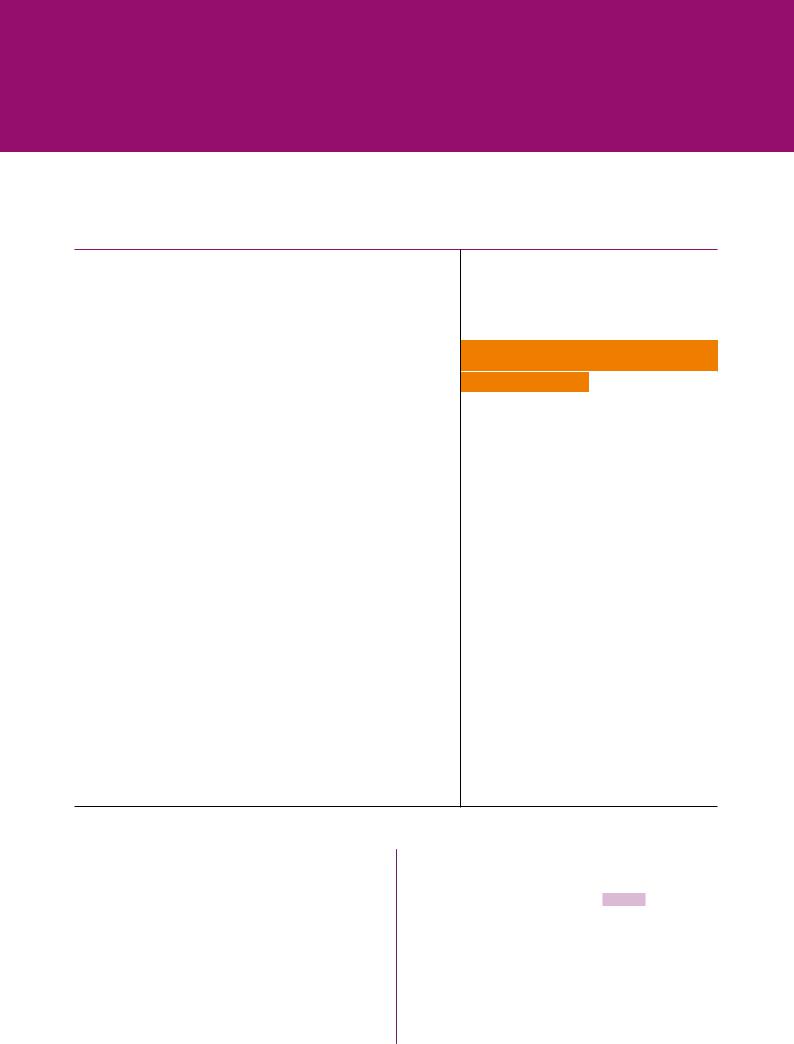
Agricultural commodity markets
.pdf
vk.com/id446425943
THE STATE OF AGRICULTURAL COMMODITY MARKETS 2018
BOX 3.1
IMPLEMENTATION MECHANISMS UNDER THE KYOTO PROTOCOL AND PARIS AGREEMENT
While the Paris Agreement lacks common standards, enforcement mechanisms, or sanctions for non-compliance, the UNFCCC predecessor agreement, the Kyoto Protocol (2007), described in some detail both domestic and international Joint Implementation measures. Such measures included Emissions Trading Schemes (ETS) and their joint mechanism International Emissions Trading (IET), the Clean Development Mechanism (CDM), the Green Investment Scheme (GIS) and the Border Adjustment Measures (BAM).
At the same time, while the implementation mechanisms were far clearer, the binding nature of the commitment, along with the burden absorbed largely by the developed world, prevented a number of countries – including the United States of America, the world’s top emitter of GHGs at the time of signing
– from ratifying the legislation domestically.
The Paris Agreement is flexible with regard to the implementation tools; it leaves the choice – and the
responsibility to respect international trade and investment rules – to the countries. Effectively, it relies on incentives through peer pressure. The "global stocktake" every five years provides an opportunity to review national contributions and to encourage higher ambitions. Together with a standing committee on implementation and compliance and technical expert reviews, this mechanism enables a focus on political and technical aspects of performance.
Despite the lack of explicit guidance on instruments, however, the Paris Agreement encourages the use of market-based mechanisms by countries to meet their NDC commitments. It also acknowledges the important role of collective implementation and joint adaptation and mitigation approaches in achieving the collective target of keeping the rise in average temperature significantly below 2 °C.
SOURCE: Häberli, C. 2018. Potential Conflicts Between Agricultural Trade Rules and Climate Change Treaty Commitments. SOCO 2018 Background Paper, Rome, FAO; Giroud, J., Lancesseur, N. and Roulleau, T. 2016. Economic Analysis of the Paris Agreement. Trésor Economics, No. 187, December.
policy frameworks through which countries communicate their proposed climate actions to the international community and report on the progress made towards achieving them.39 It is not compulsory to meet the targets outlined in the NDCs, but countries are expected to pursue domestic mitigation measures with the aim of achieving their goals.40 Moreover, the Agreement urges countries to strengthen their efforts progressively through a “ratchet mechanism,” whereby countries are expected to update their commitments to reflect the highest possible ambition every five years, starting in 2020.
The NDCs will be assessed through periodic global stocktaking exercises, the first of which will take place in 2023, in preparation for a new set of policy frameworks to be implemented
during 2026–2030. While all countries are required to participate, the assessment will be based on the achievement of collective efforts at the global level. In addition, the stocktaking will also assess whether sufficient assistance is provided by developed countries to developing countries, reconfirming that although all countries participate in adaptation and mitigation efforts, developed countries are to take the lead on various areas of action outlined in the
accord.41
The importance of agriculture (crops and livestock) for climate change adaptation and mitigation efforts, and the sector’s vulnerability to climate-related shocks and changes is clearly recognized in NDCs submitted to date.42 Mitigation in agriculture features in close to
| 33 |

vk.com/id446425943
PART 3 AGRICULTURAL TRADE AND CLIMATE CHANGE: EXPLORING THE POLICY SPACE
80 percent of the Intended Nationally Determined Contributions (INDCs)43 submitted as of 2016, a share second only to the energy sector. Together, countries that include agriculture in their mitigation contributions account for over
90 percent of global agricultural emissions.44 Similarly, more than 90 percent of INDCs submitted by developing countries refer to priority areas for adaptation in the agricultural sector, underlining the role of agriculture in promoting food security and providing a primary source of rural income.
The bottom-up approach and flexibility of the Paris Agreement has allowed a broader set of countries to reach a political consensus. This has avoided the shortcomings of the Kyoto Protocol, where legally binding targets for lower emissions and enforcement mechanisms alienated key emitters from participating in the accord. However, this greater discretion has not escaped criticism. The absence of binding emissions reduction targets at a national level and the lack of enforcement tools have raised concerns about the ability of the accord to hold countries accountable and to provide incentive structures that align national actions.
In most INDCs that include agriculture in mitigation efforts, emissions targets are included as part of broader, often economy-wide targets, without reference to concrete actions in agriculture for achieving these goals. INDCs of developed countries tend to be particularly vague, often expressed as a general commitment on economy-wide targets.45 Developing country INDCs tend to offer greater detail, many of them specifying climate actions to be undertaken in agriculture, alongside a more ambitious target conditional on technology transfer, capacity building and financial support from developed countries.46
Even the NDCs that display greater sectoral focus do not specify the instruments that will be used to deliver on commitments. The NDC of New Zealand, a country where agriculture accounts for a relatively large share of the country’s economic activities, commits to reducing economy-wide emissions in absolute terms by 30 percent compared to 2005 levels, but leaves open the question of the specific policies that will be used
to achieve this target. Indonesia’s aim to promote sustainable agriculture and plantations or Pakistan’s intention to promote no-till farming to improve soil carbon storage are more specific but can likewise be pursued through a myriad of domestic policy measures, ranging from taxes and subsidies to regulations and standards.
Clearly, much of the work to translate the Paris Agreement and the NDCs into concrete climate action is in the making, and a comprehensive assessment of how effective these policy frameworks are in contributing to adaptation and mitigation efforts can only be carried out in time. Yet, the limited reference to specific instruments in the NDCs submitted so far may also be attributed to technical challenges in designing and implementing appropriate policies – which may also include interactions between climate accords and trade regimes.47 Under the flexibility granted through the Paris Agreement, global climate action will largely be driven by countries’ NDCs. How those commitments are pursued in practice – using measures ranging from subsidies to standards – will in turn affect production, emissions and trade flows and, in some cases, will need to be considered in the light of multilateral trade rules.48 Such concerns need to be well understood and discussed to provide guidance to policy-makers.
The flexibility permitted under the Paris Agreement provided the space to negotiate the trade-off between universal participation, on the one hand, and the precision and ambition of the commitments, on the other. Moving forward, it will be necessary to provide an incentive structure that cultivates mutual support and trust to build confidence and commitment for deeper collaboration.
The initial steps have been taken, as Parties to the Paris Agreement are working towards creating the space for collective consultation. Parties to the Agreement have expressed their commitment to work on standard setting, including for agriculture. For instance, the Koronivia Joint Work on Agriculture,49 established at the Twenty-third Conference of the Parties (COP 23) in November 2017, sets up a framework through which technical knowledge can be bridged with climate action. The Talanoa
| 34 |

vk.com/id446425943
THE STATE OF AGRICULTURAL COMMODITY MARKETS 2018
Dialogue, an initial stocktaking exercise spanning the course of 2018 (the first full global stocktake takes place in 2023), marks an important first step forward in the commitment to strengthening the ambition in the NDCs progressively in five-year steps.50
Given the broad spectrum of policy tools available to policy-makers in implementing the Paris Agreement on agriculture, it will be important to deepen the discussion on the impact of those measures not just on climate change but also on agricultural production, trade and food security, and their potential interaction with global trading rules. Such a discussion will be important to encourage implementation of NDCs and to reduce potential concerns. As countries begin to deliberate on the timeline and nature of NDC pledges and review processes, a better understanding of the interaction between the Paris Agreement and multilateral trade rules will be necessary to ensure that these agreements interact in productive ways to provide a mutually supportive environment for climate change adaptation and mitigation policies.
WTO principles and key disciplines relating to agriculture
Established in 1995 as the successor to the General Agreement on Tariffs and Trade (GATT), the WTO serves as an institutional umbrella for treaties governing international trade. The principal objective of the WTO is to create a transparent and predictable system of international trade rules and to promote progressive liberalization of trade by minimizing trade distortions.
This objective is pursued through a range of agreements covering trade in goods, trade in services and trade-related aspects of intellectual property rights, adopted as a whole and indivisible package. This includes the GATT, the AoA, and a number of other agreements, inter alia, on Subsidies and Countervailing Measures (SCM), Sanitary and Phytosanitary Measures (SPS) and Technical Barriers to Trade (TBT).
Central to WTO disciplines is the principle of non-discrimination, aimed at ensuring fair and equitable treatment of all participants. The
non-discrimination principle is elaborated for trade in goods through the most-favoured nation (MFN) obligation (Article I of GATT), prohibiting discrimination between like products of different foreign origins, and the national treatment (NT) obligation (Article III of GATT) which prohibits discrimination between like products of foreign and domestic origin. The principle of non-discrimination is also reflected in other WTO agreements, notably the TBT Agreement (see Part 6).
The WTO agreements recognize the importance of other objectives, notably through Article XX of GATT on General Exceptions, which allows Members to take all necessary measures “to protect public morals,”51 “to protect human, animal or plant life or health,”52 or “relating to the conservation of exhaustible natural resources if such measures are made effective in conjunction with restrictions on domestic production or consumption.”53 However, these measures may not be applied “in a manner which would constitute a means of arbitrary or unjustifiable discrimination between countries where the same conditions prevail, or a disguised restriction on international trade.”54 The legitimacy of non-trade policy objectives, including protection of public health or the environment, is also reflected in other WTO agreements.55
The main challenge likely to be faced by mitigation policies on agriculture relates to the non-discrimination principle, which prohibits discrimination, for example, of otherwise “like” products differing solely in their carbon footprint as a result of different processes and production methods (PPMs). In simple terms, based on this rule it may be asked whether a country where the domestic price of meat increases as a result of adopting policies to reduce emissions in its livestock sector – due to additional costs incurred by local producers in order to comply with the new policies – would be able to level the playing field by increasing the tariff rates on meat imports produced through methods generating higher emissions.
Clearly, a meaningful analysis under WTO rules would need to take account of the nature of the specific measures envisaged and the relevant obligations at issue. If climate-smart agricultural policy measures entailed differences in the
| 35 |

vk.com/id446425943
PART 3 AGRICULTURAL TRADE AND CLIMATE CHANGE: EXPLORING THE POLICY SPACE
treatment of products of different origins, then determining the WTO compatibility of such measures could involve an assessment of:
(i) whether the imported product, produced by a method resulting in a different level of emissions compared with the domestic product, is to be considered a ‘like’ product; and, (ii) whether a given measure accords ‘less favourable’ treatment of imports than on like domestic products, and if so to what extent the regulatory distinctions between the products at issue can be explained by the pursuance of a legitimate objective.56 Part of the challenge is that the definition and measurement of carbon footprint is not determined and agreed upon internationally.
The “like product” test generally applied in WTO case rulings comprises four categories of characteristics that the products involved might share:
i.the physical properties of the products;
ii.the extent to which the products are capable of serving the same or similar end-uses;
iii.the extent to which consumers perceive and treat the products as alternative means of performing particular functions in order to satisfy a particular want or demand; and
iv.the international classification of the products for tariff purposes.57
For so-called “non-product-related PPMs” (npr-PPMs) that leave no trace in the final product – as in the case of the carbon footprint of the product – and do not alter any of its main characteristics, environmental objectives can be pursued under GATT Article XX, provided that these do not constitute arbitrary or unjustifiable discrimination. However, the application of WTO provisions to differentiating products solely based on their carbon footprint58 and the question as to whether such products can be considered not “like”, has never been raised in a WTO legal dispute.
Regarding the other condition for a violation of the non-discrimination obligation – the “less favourable treatment” and its possible justification on legitimate environmental grounds – the way an environmental standard is applied to imports as compared to local products may come under WTO scrutiny (an example of which can be seen in Box 3.2).
The principle of non-discrimination has been further articulated in the TBT Agreement applicable to technical regulations on trade, standards and mutual recognition. This Agreement would be relevant for mitigation measures and policies that would take the form of technical regulations or standards (see Part 6).
The implication of the non-discrimination principle is also further articulated in the AoA, serving as the principal source of basic disciplines on trade in agricultural products regulating border measures and support policies under three main pillars:
Market access: under the market access rules, ordinary customs duties are the only form of border protection instruments allowed. These are subject to maximum binding levels that cannot be exceeded by applied tariffs. Scheduled tariff bindings cannot be increased without compensation (Article XXVIII of GATT). All non-tariff measures (NTMs), for example quantitative import restrictions, outright import bans, variable import duties, etc., are prohibited (Article 4 of the AoA; Article XI of GATT).
Market access rules for agricultural products do allow for time-limited exceptions if certain conditions are met. For example, Article 5 of the AoA lays out conditions under which price-based or volume-based safeguard measures may be temporarily applied to address import surges. WTO rules on anti-dumping or countervailing duties also allow governments to take remedial measures against dumped or subsidized imports. Moreover, time-limited border protection against imports threatening local production is permitted under Article XIX of GATT and the WTO Safeguard Agreement, allowing governments to either apply additional duties or impose temporary quantitative restrictions.
However, as long as climate change does not constitute a valid justification under these exceptions, the use of market access measures for adaptation and mitigation purposes would be limited, unless it could be shown that products can be differentiated based on the emissions generated in their productions processes, and are eligible for different tariff rates (see Part 5 for detailed discussion).
| 36 |

vk.com/id446425943
THE STATE OF AGRICULTURAL COMMODITY MARKETS 2018
TABLE 3.1
TOTAL DOMESTIC SUPPORT
Measures that are not subject to reduction commitments. These may be used without monetary limits on support, provided the relevant implementation criteria are met. Exemption of support measures from reduction commitments may fall under the following three basic policy categories or "boxes":
Green Box |
Development Box |
Blue Box |
(AoA Annex 2) |
(Article 6.2 AoA) |
(Article 6.5 AoA) |
|
|
|
Green Box measures |
Development Box |
Blue Box measures |
include domestic |
measures provide |
are similar to Amber |
policies that are |
developing countries |
Box measures but |
considered to have |
with additional |
require farmers to |
no or minimal |
flexibility in |
limit production, thus |
impact on trade and |
providing domestic |
limiting production |
production, such as |
support. The |
distortions. At |
government services |
category covers |
present, there are no |
on research and |
measures taken by |
limits on Blue Box |
development, |
developing countries, |
subsidies. |
extension, and |
whether direct or |
|
investment in |
indirect, that are an |
|
infrastructure. Also |
integral part of their |
|
included are direct |
development |
|
payments to |
programmes and |
|
producers of basic |
encourage |
|
agricultural |
agricultural and rural |
|
products, such as |
development. These |
|
income support that |
include investment |
|
is decoupled from |
subsidies that are |
|
production, |
generally available |
|
assistance to |
to agriculture, |
|
promote structural |
agricultural input |
|
adjustment in |
subsidies generally |
|
agriculture, and |
available to |
|
direct payments |
low-income or |
|
under environmental |
resource-poor |
|
and regional |
producers, and |
|
assistance |
domestic support to |
|
programmes. |
producers to |
|
|
encourage |
|
|
diversification from |
|
|
growing illicit |
|
|
narcotic crops. |
|
Measures that are subject to scheduled reduction commitments and bound limits. Measures that do not meet the exemption criteria of Green Box, Development Box, or Blue Box, are often referred to as Amber Box measures.
Amber Box
(Article 6 AoA)
|
De minimis |
The Amber Box |
De minimis levels are |
includes measures to |
minimal amounts of |
support prices or |
domestic support |
input subsidies |
that are allowed |
directly related to |
even though they |
production. This |
distort trade – up to |
support is subject to |
5 percent of the |
limits: 32 WTO |
value of production |
members that had |
for developed |
non-exempt domestic |
countries, 10 percent |
support during the |
for most developing |
base period |
countries. The de |
undertook reduction |
minimis provision |
commitments. |
applies both to |
Members without |
support associated |
such commitments |
with a specific |
must limit their |
product and |
Amber Box support |
non-product-specific |
within the de minimis |
support. |
levels. The reduction |
|
commitments are |
|
expressed in terms of |
|
the “Total Aggregate |
|
Measurement of |
|
Support” (Total |
|
AMS), which |
|
effectively bounds |
|
trade-distorting |
|
support. |
|
Domestic support: The AoA places a limit on the use of support measures in favour of agricultural producers that are considered to be productionand trade-distorting (so-called Amber Box); the magnitude of such support is assessed using the aggregate measurement of support (AMS) calculation methodology. The provision of support that is judged to be nonor minimally trade-distorting (so-called Green Box measures) in conformity with established criteria is not subject to monetary limits. Product-specific and non-product-specific amber support to agricultural producers is not accounted for in the
AMS if it does not exceed specified de minimis levels. Direct payments under production limiting programmes (so-called Blue Box measures) are not subject to monetary limits. Table 3.1 provides a more detailed description of WTO disciplines on domestic support.
Trade-distorting support that would otherwise be covered by Amber Box provisions is permitted without monetary limits if used by developing countries as investment subsidies generally available to agriculture, input subsidies targeting low-income or resource-poor producers, or
| 37 |

vk.com/id446425943
PART 3 AGRICULTURAL TRADE AND CLIMATE CHANGE: EXPLORING THE POLICY SPACE
measures to encourage diversification away from growing illicit narcotic crops (the so-called Development Box). However, adaptation to climate change is not directly cited as a motive for policies seeking relief under Article 6.2, and no case has been brought under the WTO dispute mechanism.
Export competition: At the Tenth WTO Ministerial Conference in Nairobi in 2015, a decision was taken to eliminate export subsidies in accordance with an agreed timetable. In parallel, new disciplines were also agreed on other potentially relevant export competition instruments, namely export credits, international food aid, and exporting state-trading enterprises. These disciplines complement other relevant WTO provisions notably under the Subsidies and Countervailing Measures Agreement, the AoA, and GATT Article XVII on state-trading enterprises. n
RELATIONSHIP BETWEEN WTO REGULATIONS AND THE PARIS AGREEMENT
In principle, there is no fundamental conflict between climate change policies and trade rules. UNFCCC explicitly states that measures taken to combat climate change should not constitute a means of arbitrary or unjustifiable discrimination or a disguised restriction on international trade. The 2030 Agenda for Sustainable Development reinforces the idea that an open, non-discriminatory, multilateral trading system and actions that protect the environment and promote sustainable development can and must be mutually supportive.
Within the WTO, countries are granted a large measure of autonomy in determining their environmental objectives and the environmental legislation they enact and implement, insofar as it respects the requirements of WTO principles. While the non-discrimination obligation is a guiding principle in the WTO, the importance of other objectives, including environmental ones, is recognized within its rules and regulations through exceptions that form an integral part of the WTO agreements and should be considered together with the basic disciplines. The preamble
to the Marrakesh Agreement, for instance, recognizes the importance of coordinating policies on trade and environment, stating that the WTO aims at:
allowing for the optimal use of the world’s resources in accordance with the objective of sustainable development, seeking both to protect and preserve the environment and to enhance the means for doing so in a manner consistent with their respective needs and concerns at different levels of economic development.59
Within the GATT 1994, Article XX on General Exceptions offers additional provisions intended to ensure that commitments undertaken by the members do not hinder the pursuit of legitimate policy objectives. These include the protection of human, animal or plant life or health and the conservation of exhaustible natural resources, so long as these are implemented in a manner consistent with the principle of
non-discrimination.
In this regard, under various WTO agreements, in principle the protection of the environment qualifies as a legitimate justification for climate change adaptation and mitigation policy measures that would otherwise violate WTO rules.60
For example, in the US — Gasoline case, the only fossil fuel case settled to date in a formal dispute,61 the Appellate Body (AB) ruled that the manner in which the air contamination standards were applied – providing for more stringent rules to imported gasoline than to domestic gasoline – constituted an unjustifiable discrimination and a disguised restriction on international trade, violating the non-discrimination condition of Article XX (Box 3.2).
Within the WTO, the AB and the Panels62 – the adjudicating bodies of the WTO’s Dispute Settlement Body (DSB) – clarify as relevant the existing agreements that define the policy space and respect internationally agreed values, including environmental norms and human rights. However, neither the Appellate Body nor the Panels themselves are allowed to make new rules. Instead, they must look at the various provisions foreseen in the WTO agreements and invoked by the parties.
| 38 |

vk.com/id446425943
THE STATE OF AGRICULTURAL COMMODITY MARKETS 2018
BOX 3.2
THE US — GASOLINE CASE
The US — Gasoline case, one of the first to be brought before the WTO dispute settlement mechanism, dealt with a regulation by the United States Environmental Protection Agency under the Clean Air Act of 1990, to control toxic and other pollution caused by the combustion of gasoline manufactured in or imported into the United States of America.
The regulation established certain compositional and performance specifications for reformulated gasoline. The point of contention was that the regulation set out different methods for establishing baseline figures for domestic and imported gasoline sold on the United States of America market – a case of “less favourable treatment”.
Clean air was recognized as constituting an exhaustible natural resource falling within the scope of Article XX(g) of GATT, which provides for exceptions on the basis of conserving exhaustible natural resources if such measures are made effective in conjunction with restrictions on domestic production or consumption. While the Appellate Body found that the regulation was a measure relating to the conservation of exhaustible natural resources, it nonetheless concluded that, as applied, the measure failed to meet the requirements of the chapeau of Article XX of the General Agreement because the so-called baseline establishment rules in the US regulation – whereby sellers of domestic gasoline were authorized to use an individual baseline, while sellers of (chemically identical) imported gasoline had to use the more onerous statutory baseline – “are not justified under Article XX of the General Agreement”.
SOURCE: Appellate Body Report, US – Gasoline, dated 29 April 1996, p.28 lit.a and c, cited in Häberli, C. 2018. Potential Conflicts Between Agricultural Trade Rules and Climate Change Treaty Commitments. SOCO 2018 Background Paper, Rome.
At the same time, although the Dispute Settlement Body findings constitute useful interpretation of WTO rules, each and every ruling only applies to the case at hand, and cannot be considered a final interpretation: litigating parties and adjudicators can always
argue in another case that a different interpretation is more appropriate. In turn, the authority to issue a legally binding interpretation rests with the Ministerial Conference and the General Council (Article IX:2 of the WTO Agreement), as opposed to an interpretation in dispute settlement.63
WTO provisions can also be the subject of amendments. The Ministerial Conference or the General Council take such decisions (Article X of the WTO AoA). There have only been three amendments to the WTO AoA since its inception. These include the “affordable drugs” amendment of the Trade-Related Aspects of Intellectual Property Rights (TRIPS) Agreement, which allowed a rules amendment to protect the public health needs of people in poor countries.64
A similar procedure applies to waivers, which can be used to exempt a particular WTO member or group of members from the duty of complying with specific rules and obligations. Although more frequent and somewhat easier to obtain than amendments, waivers are subject to time limits, and each extension must be justified.65 For example, the Kimberley Waiver was adopted in 2006 to allow importers to deny MFN market access rights to so-called “blood diamonds” (revenue from sales of which financed authoritarian regimes, oppression and conflict).66 It sits at the juncture of trade and human rights and is the only case involving “non-product-related PPM” of potential relevance for measures intended for climate change adaptation and mitigation.
The scope of existing exceptions, amendments and waiver clauses leaves room for accommodating the potential implications for the non-discrimination principle of measures aimed at climate change adaptation and mitigation. However, for effective adaptation and mitigation policies, a thorough discussion is needed on climate-smart measures and the corresponding WTO disciplines, particularly on the possibility of differentiating agricultural products based on non-product-specific PPM. n
| 39 |

vk.com/id446425943
PART 3 AGRICULTURAL TRADE AND CLIMATE CHANGE: EXPLORING THE POLICY SPACE
POLICY SPACE FOR EFFECTIVE IMPLEMENTATION OF NATIONALLY DETERMINED CONTRIBUTIONS (NDCs)
Discussions on the interpretation and application of WTO disciplines in the context of climate change adaptation and mitigation will be particularly important.
There is scope for WTO members to pursue legitimate environmental protection objectives. However, the application of the rules in regard to treatment of identical agricultural products that differ solely in their carbon footprint remains untested – a challenge for climate change measures, which often target processes and production methods. Depending on their design and application, certain measures, such as subsidies and taxes, which could be used to implement the Paris commitments, may potentially encounter challenges under the trade rules.
With few available INDCs/NDCs specifying the intention or policy measures to reduce emissions along food systems, translating the ambition of the Paris Agreement may be a challenge. At the same time, this challenge can present an opportunity for policy-makers to consider policies that will contribute towards reducing emissions globally.
In practice, this challenge stems in part from the lack of an internationally-agreed definition of carbon footprint, which could constrain the discussions.
While maximum policy space for discussions is needed on the juncture of the WTO agreements and the Paris Agreement, the policy space should also ensure that national measures do not negatively affect other countries or unduly restrict trade and investment, especially in developing countries. This development dimension poses a particular challenge under the multilateral trade rules. Developed countries and
those where agriculture is a relatively small sector are clearly in a different position in their choices to poor countries. This is especially true for poor countries with a high carbon footprint, as is often the case where small-scale and subsistence farmers, nomads, and fishers are representative of the agricultural sector.
The WTO agreements contain special provisions that give developing countries certain flexibilities, for instance longer time periods for implementing agreements and commitments, or measures to increase trading opportunities (see Box 3.3). While the Paris Agreement requires all countries to take the development dimension into account when formulating their NDCs, each country has the flexibility to select the policy tools that it considers climate smart or development friendly, taking account of prevailing conditions and individual circumstances.
As the multilateral peer review process of the NDCs has not yet taken place, it is difficult to propose solutions in concrete terms. In this regard, the discussion on the WTO rules and the Paris Agreement would help identify policy areas and measures:
i.that are not subject to commitments;
ii.where quick solutions for strengthening the mutual supportive approach might be available; and
iii.where a review of trade rules (or waivers thereof) and available international standards might be necessary.
Policy tools should only be chosen after a thorough review and assessment of the relative costs and benefits in a given context. For instance, incentives to promote climate-smart policies may not qualify for the Green Box, irrespective of their role in reducing emissions (see Part 4 for a discussion on domestic support). Similarly, a carbon tax might be climate-smart, yet more trade-restrictive than a subsidized sequestration programme (see Part 5 for a discussion on trade implications of a carbon tax).
Climate change is likely to affect agriculture even more than other sectors, and small-scale producers in developing countries – the majority of the world’s family farmers – will be among those facing the greatest challenge in the
| 40 |

vk.com/id446425943
THE STATE OF AGRICULTURAL COMMODITY MARKETS 2018
BOX 3.3
DEVELOPING COUNTRIES: SPECIAL AND DIFFERENTIAL TREATMENT
The different challenges faced by developing and developed countries are recognized in the Paris Agreement and in WTO agreements. The Paris Agreement recognizes differentiated responsibilities and capacities and stresses the role of international cooperation, in particular through its provisions on financial and technical assistance to help developing countries meet their mitigation and adaptation objectives. In the WTO agreements, the distinction is recognized through the special and differential treatment (SDT) for developing countries.
In recent years SDT has focused on helping developing countries seize opportunities to expand exports, most notably through Aid for Trade. In the context of climate change, the Aid for Trade initiative can be strengthened both to enhance resilience in the agricultural sectors of developing countries and to enable them to cope with the challenges and opportunities that might be created for the international trading system by climate change.
In the context of climate policy, SDT implies that developing countries, particularly LDCs, could be accorded longer adjustment periods to meet stringent obligations and product standards relating to carbon footprint. Priority could also be placed on capacity building and the provision of technical assistance that facilitate transitioning to a lower-emission food and agricultural system – for instance by implementing
technical standards and assistance with carbon accounting for certification. Labelling could be another useful mechanism to promote the sale of sustainable, low-carbon food products from developing countries in importing countries (see Part 6).
In some cases, international trade could adversely contribute to climate change by stimulating the production of agricultural products with high carbon footprint. Palm oil production in Asia provides a case in point, where global demand and trade resulted in widespread deforestation and increase in the use of high-emitting peatland. In the longer run, however, the transition to lower-emissions agricultural and food systems is less dependent on trade and more reliant on the transfer and adoption of improved technology and on adopting appropriate domestic policies that are land-sparing and stimulate improvements in agricultural productivity, so that emissions per unit of output are reduced.
In this regard, while it is important that trade provides sufficient mechanisms to help developing countries manage short-term weather-induced production shortfalls and emergencies, trade policy measures must also ensure that appropriate domestic measures are taken to increase the resilience of agriculture and the economy more generally, helping countries to increase stability in international markets for basic agricultural commodities.
SOURCE: Blandford, D. 2018. Border and related measures in the context of adaptation and mitigation to climate change. SOCO 2018 Background Paper, Rome, FAO.
absence of efficient, effective, and climateand trade-friendly solutions. In this regard, key issues identified in this report require consideration across multiple international platforms, including those around climate (UNFCCC/COP), development (Sustainable Development Goals), and multilateral trade. Intergovernmental cooperation will be particularly important for constructing a tradeand development-friendly framework for the elaboration of climate-smart policies under the Paris Agreement. On 14 November 2017, COP23 decided to “address issues related to agriculture,
[...] taking into consideration the vulnerabilities of agriculture to climate change and approaches to addressing food security.”67 If countries are to move forward with the implementation of policies that are effective in achieving climate change adaptation and mitigation, while at the same time meeting other international objectives – such as a fair multilateral trading system, and the implementation of the 2030 Agenda for Sustainable Development – an approach that strengthens the mutually supportive role of corresponding agreements will need to be discussed. n
| 41 |

vk.com/id446425943
PERU
Native women in the field sifting quinoa ©FAO/Heinz Plenge (FAO/MINAG)
